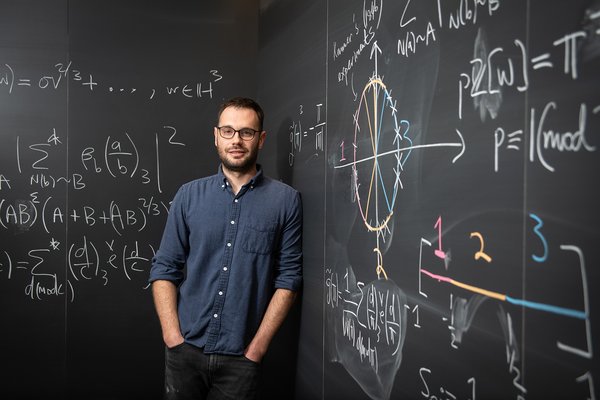Assistant Professor in the School of Mathematics Alexander Dunn has been honored for his contributions to the field of mathematics by the Shanmugha Arts, Science, Technology, and Research Academy (SASTRA). The prize is awarded annually to an outstanding individual under the age of 33 whose contributions are broadly influenced by the work of Indian mathematician Srinivasa Ramanujan (1887-1920).
“I am both deeply honored and thrilled to receive the SASTRA Ramanujan Prize,” says Dunn, whose research centers on analytic number theory as well as automorphic/metaplectic forms and their connections to prime numbers and integer partitions. “Ramanujan’s work has had surprising and profound influences over my research, and I hope that this is the case for the future.”
School of Mathematics Chair Michael Wolf says the honor is remarkable: “The award celebrates breakthrough work of Alex and his collaborator in the past few years. But especially given the list of previous winners, many of whom went on from this award for young people to become the most recognized of their generation, it also shows the promise that Alex has for important impactful work in the future. We couldn't be happier that he agreed to join our faculty last year.”
Solving a 19th-century mystery
The SASTRA Ramanujan Prize was awarded in recognition of Dunn’s work in solving the Kummer-Patterson Conjecture on the distribution of cubic Gauss sums, work he began while a postdoctoral scholar at the California Institute of Technology. Dunn collaborated with Mathematics Professor Maksym Radziwill to write a conditional proof on the Conjecture, which explains a mathematical mystery about bias, or non-randomness, in the pattern of sums involving prime numbers. Their paper, which has been accepted for publication in the journal Annals of Mathematics, represents a significant breakthrough in the field of analytic number theory.
Dunn and Radziwill’s conditional proof comes nearly two centuries after the German mathematician Ernst Kummer first examined the distribution of cubic Gauss sums for the first 45 nontrivial primes. In 1846, Kummer discovered a bias — specifically, a clustering of the sums along the positive side of the number line — instead of a more even distribution. However, subsequent researchers using early computers to calculate larger samples of sums did not replicate this bias.
Then, in 1978, Samuel Patterson proposed that the bias could be “overwhelmed” in a larger sample size, resulting in the apparently uniform distribution that early computers had shown. The proof written by Dunn and Radziwill serves to both explain the bias observed by Kummer and confirm Patterson’s conjecture, solving a nearly two-century-old mystery.
About Alexander Dunn
Dunn, who joined the College as a faculty member last year, graduated with a Bachelor of Science with honors from the University of Queensland in Australia, receiving the University Medal for his academic performance. He obtained a Ph.D. in Mathematics from the University of Illinois at Urbana-Champaign and was awarded the Paul T. Bateman Fellowship in Number Theory to write his dissertation and the Bateman Prize in Number Theory for his thesis. During 2020-23, Dunn served as the Olga Taussky and John Todd Instructor in Mathematics at the California Institute of Technology. In the spring of 2021, he was a Junior Fellow at the Institut Mittag-Leffler Institute in Sweden.
About the SASTRA Ramanujan Prize
Established in 2005 by the Shanmugha Arts, Science, Technology, and Research Academy (SASTRA), the SASTRA Ramanujan Prize is an annual award bestowed to mathematicians aged 32 and younger who have made outstanding contributions to the field. The award, which was named after the Indian mathematician Srinivasa Ramanujan, includes a $10,000 prize.
About Georgia Tech
The Georgia Institute of Technology, or Georgia Tech, is one of the top public research universities in the U.S., developing leaders who advance technology and improve the human condition. The Institute offers business, computing, design, engineering, liberal arts, and sciences degrees. Its more than 47,000 undergraduate and graduate students represent 54 U.S. states and territories and more than 143 countries. They study at the main campus in Atlanta, at instructional sites around the world, or through distance and online learning. As a leading technological university, Georgia Tech is an engine of economic development for Georgia, the Southeast, and the nation, conducting more than $1 billion in research annually for government, industry, and society.
For More Information Contact
Lindsay C. Vidal
Assistant Director of Communications
College of Sciences



